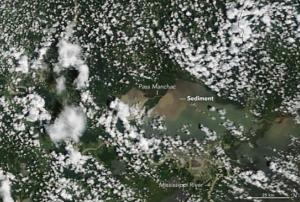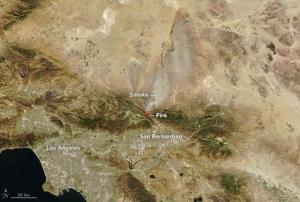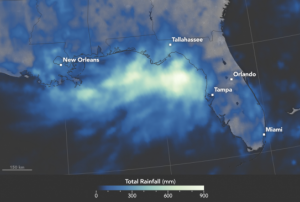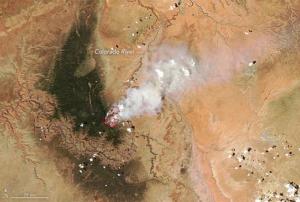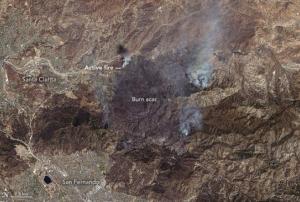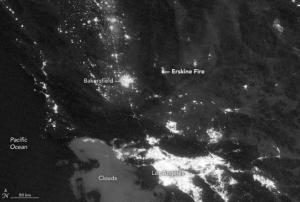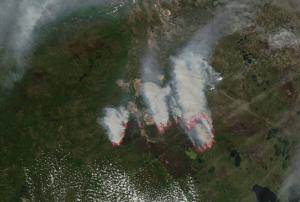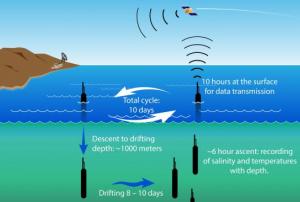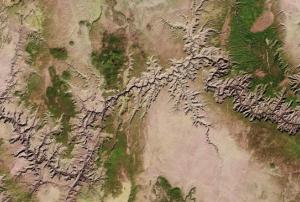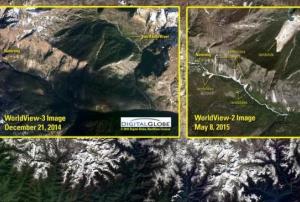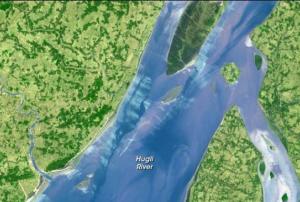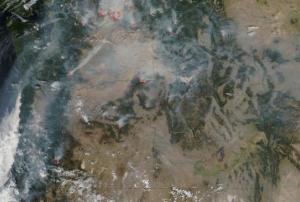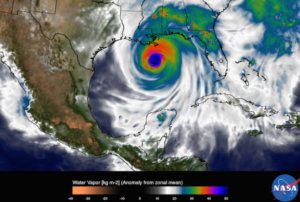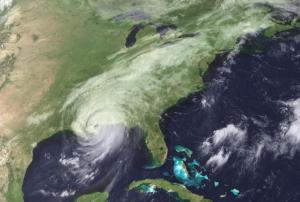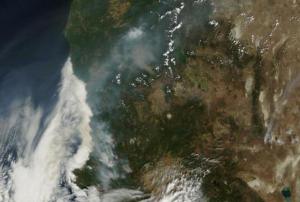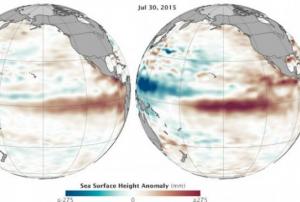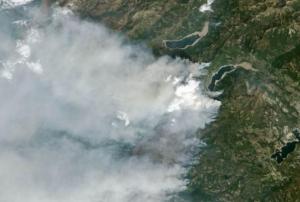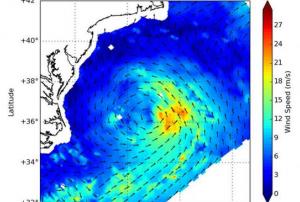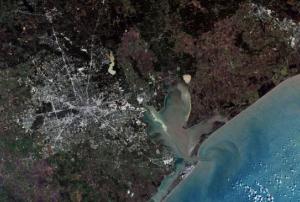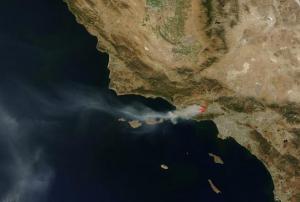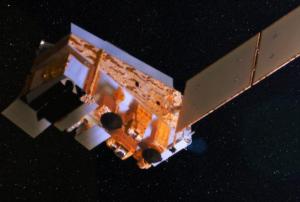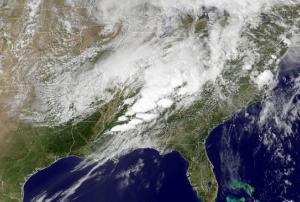United States of America
country taxonomy block
On the 16th of August 2016, the Moderate Resolution Imaging Spectroradiometer (MODIS) on the Aqua satellite of the National Aeronautics and Space Administration (NASA) detected smoke and warm surfaces affecting San Bernardino, California.
On the 17th, the fire had burned 30,000 acres and forced more than 82,000 people to abandon their houses.
"In my 40 years of fighting fire, I've never seen fire behavior so extreme," Incident Commander Mike Wakoski told the Associated Press (https://weather.com/news/news/california-wildfire-emergency-bluecut-fire-clayton-fire...
moreThe Integrated Multi-satellite Retrievals for Global Precipitation Measurement (IMERG) of the National Aeronautics and Space Administration (NASA) gathered data on heavy rainfall in the southeast part of the United-States of America.
The downpour affected mostly the north of the Gulf of Mexico with precipitations between 500 and 900 millimeters over the Gulf of Mexico. With precipitations ranging between 300 and 400 millimeters, some areas in Florida and Louisiana may experience floods in low-lying areas. The State of Mississippi and other parts of Louisiana are expected to be affected by heavy rainfall in the coming days as well.
On the 16th of July 2016, the Moderate Resolution Imaging Spectroradiometer (MODIS) on the Aqua satellite from the National Aeronautics and Space Administration (NASA) caught smoke images from space which are related to a fire on the North Rim of the Grand Canyon in Arizona. The red spot on the picture show where the MODIS system detected unusual high temperatures.
The fire was still burning on the 26th of July, according to the National Interagency Fire Fighter.
On the 22nd of July 2016 a fire occurred in southern California, United States. The Moderate Resolution Imaging Spectroradiometer (MODIS) on the Terra satellite from the National Aeronautics and Space Administration (NASA) acquired some images of the phenomenon during and after the burn.
On July 25th the fire burned more than 33,100 acres displacing people from more than 10,000 homes. Dozens of buildings have been destroyed in the nearby cities of Santa Clarita and San Fernando. The sand fire left a scorch dark mark on the landscape as visible on the picture.
2,900 firefighters from Los Angeles County and the U.S. Forest Service were requested to contain the fire which was controlled of up to 10 percent on the 25th of July.
Read more about the Sand Fire ...
moreA wildfire called Erskine started on 23 June 2016 in California due to an unknown cause. It burnt 18,368 hectares of forest and 250 structures in the southwest of the United-States, causing the death of two people.
The space-based images have been captured by the Suomi NPP satellite of the National Aeronautics and Space Administration (NASA). Thanks to the day-night band (DNB) of the Visible Infrared Imaging Radiometer Suite (VIIRS) on the satellite, the latter could capture the glow of the wildfire and locate with precision its geographical extent.
According to the National Interagency Fire Center, the number of wildfires expected for the summer 2016 could be bigger than usual due to the excessive heat in some regions in the United-States.
A destructive wildfire burned through Canada’s Northern Alberta region, destroying neighborhoods in Fort McMurray and displacing nearly 90,000 people. The fire began on the 1st of May and the exact cause is still unknown. High temperatures and strong winds pushed it north-east two days later. Despite the work of more than 500 firefighters, by the 8th of May the fire had burnt 1,610 square kilometers of forest. By the 24th, the fire was still not extinguished but it had not grown either.
Thanks to the images captured by Landsat 8 – an Earth Observation satellite of the National Aeronautics and Space Administration (NASA) – some precise and relevant data had been sent to the local authorities to contribute to cope with the effects of this huge forest fire. Authorities of Fort McMurray –ordered the evacuation of about 2,400 buildings.
The International Charter on Space and Major Disasters was activated at the request of the Government...
moreThe Earth Resources Observation and Science (EROS) Center, one of the facilities of the Unites States Geological Survey (USGS) of the United States, was established in the early 1970s as the center to manage remotely sensed data, to develop ground systems for satellite missions and to conduct research on the potential applications of such remotely sensed data. Through such efforts, the EROS Center contributes to the global understanding of how changes in land use, cover, and condition affect people and nature.
Since 1991, the EROS Center has hosted the North American Global Resource Information Database of the United Nations Environment Programme (UNEP/GRID). Through such an initiative, the EROS Center has provided space satellite imagery to many of the UN Member States for more than four decades. EROS mandate prioritizes the permanent review of the world environmental situation as a way to inform UN Member States on the state of environment.
Satellite...
moreFrom 07-10 October 20015 the United Nations Platform for Space-Based Information for Disaster Management and Emergency Response (UN-SPIDER) in collaboration with the Geospatial Information and Technology Association (GITA), SharedGeo, the Secure World Foundation and Delta State University (DSU) sponsored an international workshop in Jackson (USA) on the use of geographic information systems (GIS), remote sensing in emergency management and response practices established at Mississippi Emergency Management Agency.
Funded participants from Georgia, Vietnam, Mozambique, Japan, USA and UN-SPIDER took part within seminars on the emergency management life-cycle, the incident command system, the application of open source software to emergency management, data gathering techniques using crowd-sourcing and a tour and exercise at the Mississippi Emergency Management Agency.
The international...
moreNASA and the Indian Space Research Organisation (ISRO) have joint hands to build an Earth observation satellite called NISAR (NASA-ISRO Synthetic Aperture Radar (SAR) Mission). The space artifact will be in charge of measuring changes in the Earth’s surface related to motions of the crust and ice surface, and its launch is scheduled for 2021.
Its mission will comprise snow and glacier studies in the Himalayas, monitoring of agricultural biomass over India, Indian coastal and near-shore ocean studies, and disaster monitoring and management.
NASA has already carried out research on missions with L-band and S-band SAR systems together with ISRO, in order to identify changes in the Planet’s surface in three fields: ecosystems, solid Earth and cryospheric sciences. According to AS Kiran Kumar...
moreNASA’s Earth observation Aqua satellite spotted the wildfires burning throughout California, Oregon, Washington, Idaho and Montana states on August 23. One of the most important blazes was reported in the Okanogan Complex, in Washington State. It has burned 287,704 acres (116,000 hectares) and killed three firefighters. More than 1,774 fire personnel from 33 states are currently fighting it or working to support the firefighting effort.
The Aqua satellite was launched in 2002 and is part of the NASA-centered international Earth Observing System (EOS). It is a scientific research artifact in orbit around the Earth that gathers information about precipitations, the Earth’s water cycle, soil moisture, ice cover, storms and wildfires.
It features a Moderate Resolution Imaging Spectroradiometer (MODIS), capable of detecting actively burning areas, which are coloured red on the photo, ...
moreNASA’s Goddard Space Flight Center has released a high-resolution video that simulates Hurricane Katrina’s movement across the Atlantic Ocean, then the Gulf of Mexico, and its final collision with the southern part of the United States. It combines observational data with a high-resolution model of Earth, called GEOS-5, and reflects scientists’ better understanding of heavy storms.
Ten years after the Hurricane Katrina devastation, more precise Earth observation technology has helped researchers to learn more about the factors contributing to storms' intensity and path. Therefore, they could make better forecasts and warnings aimed at saving more lives.
Some improvements in this area include the analysis of the role of the so-called "hot towers," or tall thunderstorm clouds that carry heat upward, and of wind shears that...
moreNASA has began to build its new satellite mission focused on predicting hurricanes, called Cyclone Global Navigation Satellite System (CYGNSS), with the collaboration of the University of Michigan. It will comprise eight Earth observation (EO) microsatellites which will be able to measure ocean surface winds associated with tropical cyclones, typhoons and hurricanes throughout their life cycle. Their launch is expected in late 2016 from Cape Canaveral in Florida.
The satellite constellation will offer a new image of wind speeds over the entire tropics every few hours, instead of the current space artifacts that provide them every few days. Moreover, it will be able to monitor and forecast swift changes in wind speeds, hurricane intensity and storm surges.
The CYGNSS mission passed two NASA examinations and the assembly of the first microsatellite began last August 14. Each satellite would weight roughly 64 pounds (29 kg) and measure approximately 20x25x11 inches (...
moreESRI has developed two interactive maps for wildfire monitoring in the Western coast of the United States, which can be shared and embedded into the end users' websites: the Wildfire Public Information Map and the 2015 California Wildfire Activity Map.
The first one offers updated data on wildfires (locations, perimeters, fire potential areas, global burn areas, wind conditions, and precipitation) from several agencies, such as the USDA Forest Service, Fire Modeling Institute of the US Geological Survey. Moreover, it provides weather information from the National Oceanic and Atmospheric Administration (NOAA) and AccuWeather.
The second one is used for tracking fires in California with up to date statistics from the National Interagency Fire Center (NIFC) Situation Report.
You can embed both maps into your website with the following codes:
-Wildfire Public Information Map:
<iframe width="100%" height="640px" src="...
moreScientists at NASA’s Jet Propulsion Laboratory have found that the ocean levels in Central and Eastern Pacific have increased between March and July 2015, which bears a resemblance to the conditions of the potent El Niño event of 1997-98. The research was carried out through altimetry measurements captured by the OSTM/Jason-2 satellite.
The scientists display a map where sea surface height is measured. Red colour indicates an increase in height due to higher temperatures compared to the average ones (thermal expansion), while blue shows a decrease in sea level because of temperatures lower than average (water contraction). White indicates normal sea level conditions.
They also compare the current situation with sea surface height in the Pacific during July 1997, which was captured by the former TOPEX/Poseidon mission. By analyzing the maps, they found out that the current situation seems even more intense than in 1997, when warming brought...
moreNASA has funded a new satellite-based fire detection tool in operation now at the U.S. Department of Agriculture (USDA) Forest Service (USFS).
The new tool uses high-resolution data from the Suomi National Polar-orbiting Partnership (NPP) satellite with a cutting-edge computer model to predict how a fire will change direction based on weather and land conditions. It will allow detecting smaller fires with precise detail and will help firefighters developing their tasks.
As explained in NASA’s website, “compared to its predecessors, the enhanced VIIRS fire product enables detection every 12 hours or less of much smaller fires and provides more detail and consistent tracking of fire lines during long duration wildfires – capabilities critical for early warning systems and support of routine mapping of fire progression.”
“The high-resolution data gleaned from VIIRS [Suomi NPP’s Visible Infrared Imaging Radiometer Suite] are...
moreThe US National Geospatial-Intelligence Agency (NGA) and DigitalGlobe have jointly released Hootenanny, a new open source project to enhance the way crowdsourced mapping influence geospatial big data analytics.
Through GitHub, a web-based Git repository hosting service, Hootenanny provides a scalable processing engine and interactive editing interface to help users rapidly conflate, or reconcile, map features generated from satellite imagery, unmanned aerial vehicles and mobile devices, as NGA explained.
“The commercialization of GEOINT [GEOspatial INTelligence] is leading to exponential growth of publicly available geospatial information. Hootenanny as an open source project will enable new levels of data sharing across the community that will increase our nation’s ability to quickly respond to emerging...
moreThe third Atlantic Tropical Storm of the season, Claudette, has been monitored by the RapidScat instrument that flies aboard the International Space Station.
As explained in NASA’s website: “RapidScat gathered surface wind data on the newborn Tropical Storm Claudette on July 13 from 6:31 to 9:36 UTC (2:31 a.m. to 5:36 a.m. EDT). RapidScat data showed that former System 92L had sustained winds near 24 meters per second (m/s) (53.6 mph/ 86.4 kph) in its eastern quadrant, and winds to 18 m/s (40.2 mph/64.8 kph) from the northern to southern quadrants. Winds in the western quadrant were 6 m/s (13.4 mph/21.6 kph) or less.”
The RapidScat instrument allows monitoring the movements of the newborn Claudette as well as the increase on the speed and potential weakening. This helps to predict the consequences it can cause and therefore mitigate the damages.
As a replacement for NASA’s QuickScat Earth satellite, the ISS-RapidScat is in charge of...
moreThe company of recent creation CartoFusion Technologies has developed a mapping application called SituMap that allows first responders to effectively detect an emergency situation.
SituMap is an app created by Dr. Richard Smith, Assistant Professor of Geographic Information Science and Geospatial Surveying Engineering at Texas A&M University-Corpus Christi. By acting as a tablet-like digital command center, it enables first responders to see real-time information through maps of crisis areas and therefore to plan and respond faster in emergency situations.
In Sensors & Systems website the functioning of the app is explained as follows: “With the touch of a finger, the table-size display can be zoomed, rotated, and drawn on. Like a personalized version of...
moreA new system of wildfire detection based on satellite data has recently been developed by the University of Berkeley in conjunction with Lawrence Berkeley National Laboratory, called Fire Urgency Estimation from Geosynchronous Orbit (FUEGO). It employs a satellite mounted with megapixel infrared cameras that monitors a patch of land in California. Then it sends the data to a geospatial information system on the ground that stores a large database of land use, rainfall, flammability and other factors related to fire emergency.
Astronomical satellites are exceedingly sensitive and could sense the outbreak of wildfires very early in their growth, when they are easier to contain and manage. Calculations show that with a reasonable half-meter aperture telescope and a contemporary multi-megapixel staring array sensor (as contrasted with the traditional scanning diode sensor), an extraordinary signal to noise ratio can be achieved, which is essential to quickly and...
moreBall Aerospace & Technologies Corp. is teaming up with NASA in the development of the Joint Polar Satellite System (JPSS-1), USA’s next environmental spacecraft, which will presumably be launched in 2017.
This polar-orbiting artifact’s mission will consist of collecting science-quality atmospheric, oceanographic, and land surface measurements that are crucial for the country's weather mission. It will work in conjunction with the Suomi National Polar-Orbiting Partnership Satellite (Suomi-NPP), another environmental spacecraft launched in 2011 and also built by Ball.
Ball is in charge of designing and manufacturing the JPSS-1 satellite, including the Ozone Mapping and Profiler Suite (OMPS) instrument - which measures levels of stratospheric ozone that protect the Earth's surface from damaging ultraviolet light, integrating all five instruments, and performing satellite-level testing and launch support. NASA will be responsible of acquiring...
moreThe Department of Health and Human Services (HHS) of USA has released a map based on geographic data to support during disasters and emergencies patients whose lives rely on electric medical devices.
The emPOWER map will assist Medicare (national social insurance programme) fee-for-service beneficiaries using electrical equipment, if due to an emergency their area is in danger of a power outage. To reach this purpose, the map records where the beneficiaries live and inputs the data, together with information from the National Oceanic and Atmospheric Administration (NOAA), into a Geographic Information System (GIS), a computer system that stores and displays geographic data.
“For people who rely on electricity-dependent medical equipment, prolonged power outages can mean life or death. This tool helps communities better anticipate, plan for, and respond to these unique needs of this population and improve resilience for the entire community before and after...
moreThe Department of Homeland Security of USA is using the imagery-hosting web service Terra Pixel to provide easy access to location-based imagery for state and local first responders.
Using the cloud to upload, manage and store geospatial data, DHS is able to deliver relevant imagery from past 24 hours to first responders allowing them to quickly react during disasters.
Through the Terra Pixel platform, built on the basis of the Amazon Web Service’s cloud storage infrastructure, emergency officials can have access to location-based and searchable geospatial information.
Collected imagery is sent to DHS when an incident is emerging or has just happened, Terra Pixel is then used to transfer that data with GIS-based information to personnel on the ground. In this way responders can see the incidents happening nearest to them when they access the platform.
more